Lead and Manage: Monitoring McDonald's Change Management Plan
VerifiedAdded on 2023/06/11
|7
|1734
|417
Report
AI Summary
This report provides a detailed analysis of the implementation and monitoring plan for change management strategies at McDonald's Australia. The primary goal is to enhance customer satisfaction, value employees, and improve profitability sustainably. The strategies involve regular surveys, menu innovation, social networking, international expansion, and cost leadership. The report emphasizes the importance of follow-up meetings to boost employee morale and address issues, along with the necessity of rectifying loopholes throughout the change management plan. It also highlights the role of change champions in each department to ensure initiatives are well-accepted and implemented. A final critical evaluation is undertaken to assess the plan's progress, considering costs, benefits, and opportunity costs, ultimately leading to a reported increase in profitability.
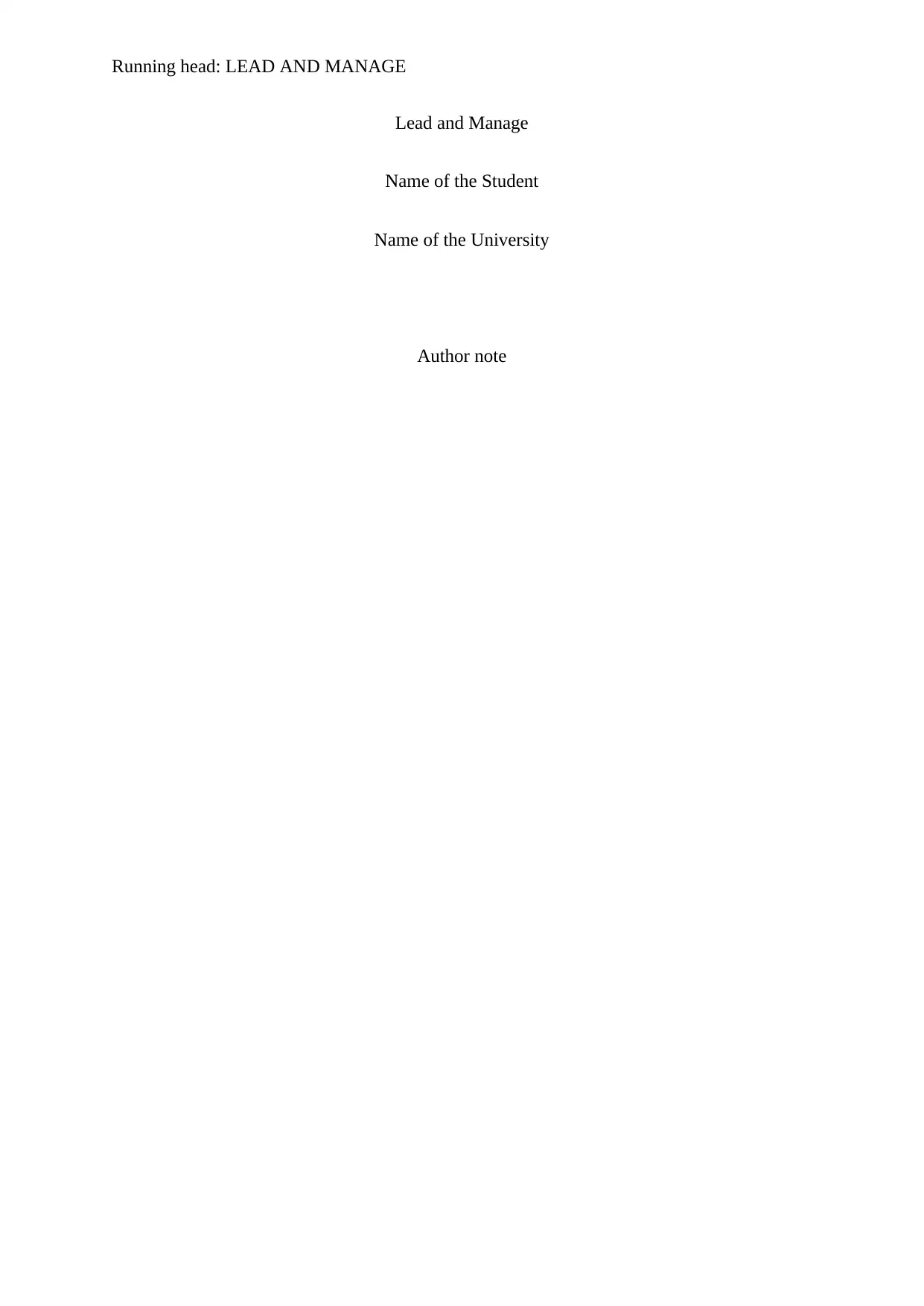
Running head: LEAD AND MANAGE
Lead and Manage
Name of the Student
Name of the University
Author note
Lead and Manage
Name of the Student
Name of the University
Author note
Paraphrase This Document
Need a fresh take? Get an instant paraphrase of this document with our AI Paraphraser
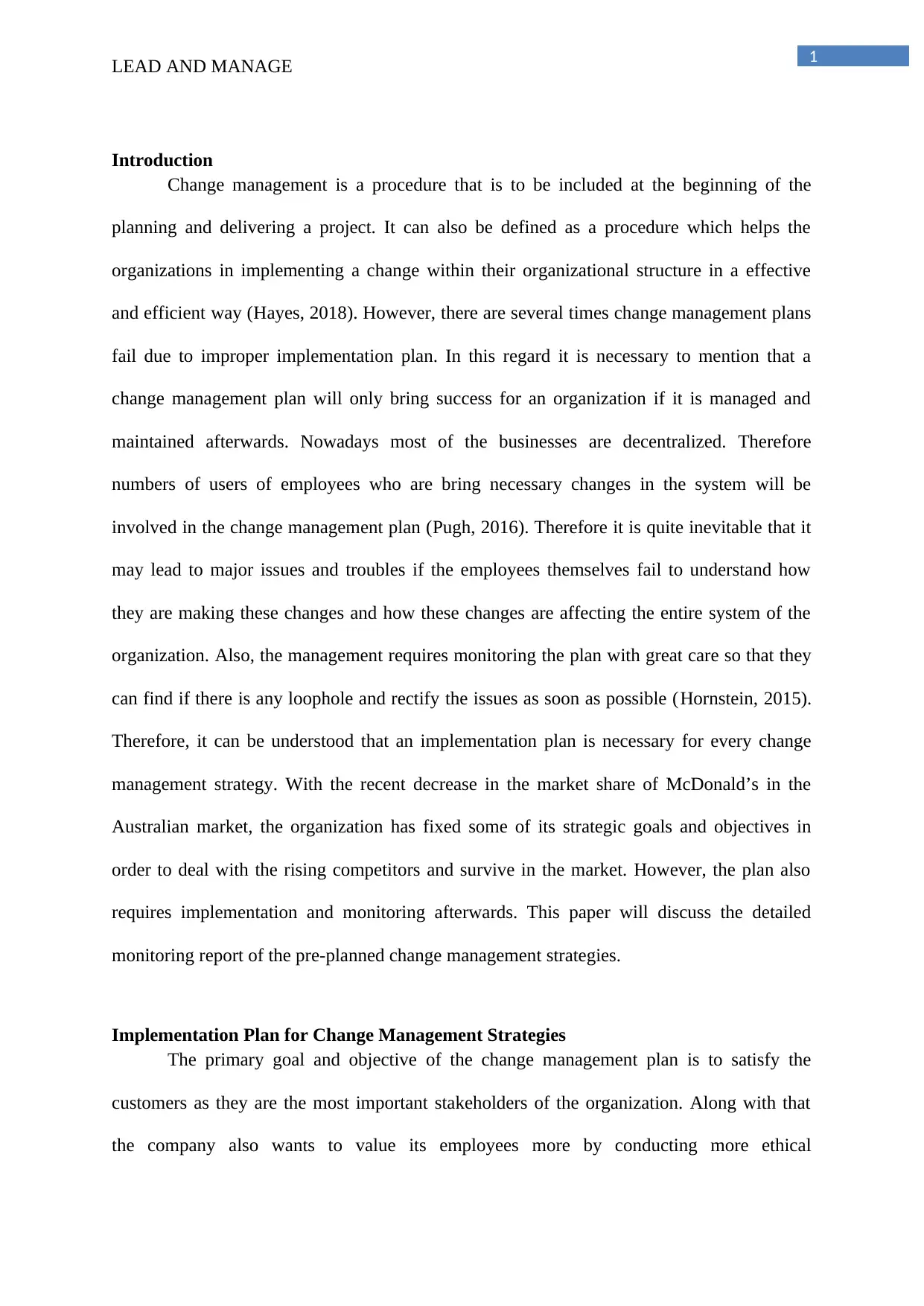
1
LEAD AND MANAGE
Introduction
Change management is a procedure that is to be included at the beginning of the
planning and delivering a project. It can also be defined as a procedure which helps the
organizations in implementing a change within their organizational structure in a effective
and efficient way (Hayes, 2018). However, there are several times change management plans
fail due to improper implementation plan. In this regard it is necessary to mention that a
change management plan will only bring success for an organization if it is managed and
maintained afterwards. Nowadays most of the businesses are decentralized. Therefore
numbers of users of employees who are bring necessary changes in the system will be
involved in the change management plan (Pugh, 2016). Therefore it is quite inevitable that it
may lead to major issues and troubles if the employees themselves fail to understand how
they are making these changes and how these changes are affecting the entire system of the
organization. Also, the management requires monitoring the plan with great care so that they
can find if there is any loophole and rectify the issues as soon as possible (Hornstein, 2015).
Therefore, it can be understood that an implementation plan is necessary for every change
management strategy. With the recent decrease in the market share of McDonald’s in the
Australian market, the organization has fixed some of its strategic goals and objectives in
order to deal with the rising competitors and survive in the market. However, the plan also
requires implementation and monitoring afterwards. This paper will discuss the detailed
monitoring report of the pre-planned change management strategies.
Implementation Plan for Change Management Strategies
The primary goal and objective of the change management plan is to satisfy the
customers as they are the most important stakeholders of the organization. Along with that
the company also wants to value its employees more by conducting more ethical
LEAD AND MANAGE
Introduction
Change management is a procedure that is to be included at the beginning of the
planning and delivering a project. It can also be defined as a procedure which helps the
organizations in implementing a change within their organizational structure in a effective
and efficient way (Hayes, 2018). However, there are several times change management plans
fail due to improper implementation plan. In this regard it is necessary to mention that a
change management plan will only bring success for an organization if it is managed and
maintained afterwards. Nowadays most of the businesses are decentralized. Therefore
numbers of users of employees who are bring necessary changes in the system will be
involved in the change management plan (Pugh, 2016). Therefore it is quite inevitable that it
may lead to major issues and troubles if the employees themselves fail to understand how
they are making these changes and how these changes are affecting the entire system of the
organization. Also, the management requires monitoring the plan with great care so that they
can find if there is any loophole and rectify the issues as soon as possible (Hornstein, 2015).
Therefore, it can be understood that an implementation plan is necessary for every change
management strategy. With the recent decrease in the market share of McDonald’s in the
Australian market, the organization has fixed some of its strategic goals and objectives in
order to deal with the rising competitors and survive in the market. However, the plan also
requires implementation and monitoring afterwards. This paper will discuss the detailed
monitoring report of the pre-planned change management strategies.
Implementation Plan for Change Management Strategies
The primary goal and objective of the change management plan is to satisfy the
customers as they are the most important stakeholders of the organization. Along with that
the company also wants to value its employees more by conducting more ethical
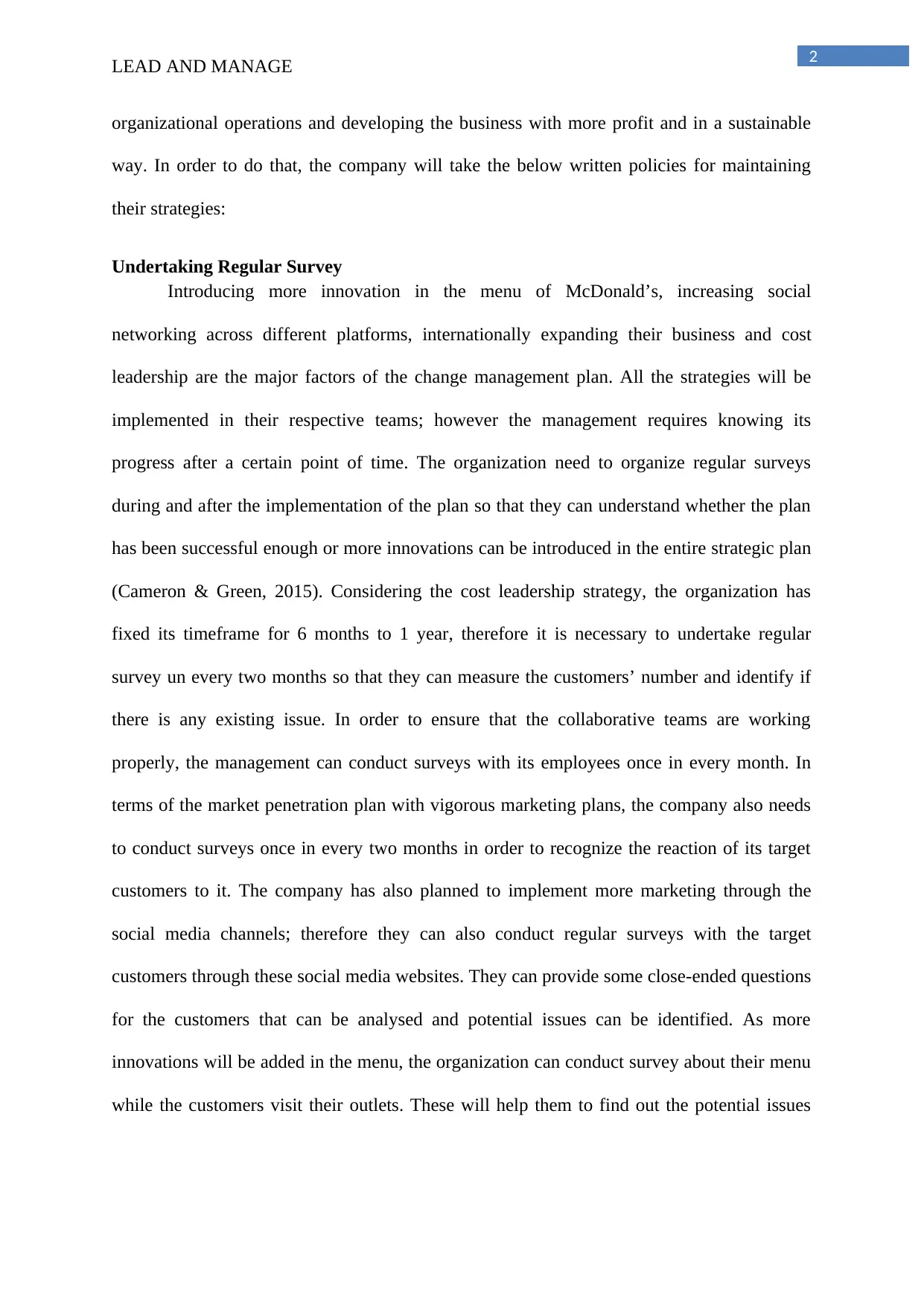
2
LEAD AND MANAGE
organizational operations and developing the business with more profit and in a sustainable
way. In order to do that, the company will take the below written policies for maintaining
their strategies:
Undertaking Regular Survey
Introducing more innovation in the menu of McDonald’s, increasing social
networking across different platforms, internationally expanding their business and cost
leadership are the major factors of the change management plan. All the strategies will be
implemented in their respective teams; however the management requires knowing its
progress after a certain point of time. The organization need to organize regular surveys
during and after the implementation of the plan so that they can understand whether the plan
has been successful enough or more innovations can be introduced in the entire strategic plan
(Cameron & Green, 2015). Considering the cost leadership strategy, the organization has
fixed its timeframe for 6 months to 1 year, therefore it is necessary to undertake regular
survey un every two months so that they can measure the customers’ number and identify if
there is any existing issue. In order to ensure that the collaborative teams are working
properly, the management can conduct surveys with its employees once in every month. In
terms of the market penetration plan with vigorous marketing plans, the company also needs
to conduct surveys once in every two months in order to recognize the reaction of its target
customers to it. The company has also planned to implement more marketing through the
social media channels; therefore they can also conduct regular surveys with the target
customers through these social media websites. They can provide some close-ended questions
for the customers that can be analysed and potential issues can be identified. As more
innovations will be added in the menu, the organization can conduct survey about their menu
while the customers visit their outlets. These will help them to find out the potential issues
LEAD AND MANAGE
organizational operations and developing the business with more profit and in a sustainable
way. In order to do that, the company will take the below written policies for maintaining
their strategies:
Undertaking Regular Survey
Introducing more innovation in the menu of McDonald’s, increasing social
networking across different platforms, internationally expanding their business and cost
leadership are the major factors of the change management plan. All the strategies will be
implemented in their respective teams; however the management requires knowing its
progress after a certain point of time. The organization need to organize regular surveys
during and after the implementation of the plan so that they can understand whether the plan
has been successful enough or more innovations can be introduced in the entire strategic plan
(Cameron & Green, 2015). Considering the cost leadership strategy, the organization has
fixed its timeframe for 6 months to 1 year, therefore it is necessary to undertake regular
survey un every two months so that they can measure the customers’ number and identify if
there is any existing issue. In order to ensure that the collaborative teams are working
properly, the management can conduct surveys with its employees once in every month. In
terms of the market penetration plan with vigorous marketing plans, the company also needs
to conduct surveys once in every two months in order to recognize the reaction of its target
customers to it. The company has also planned to implement more marketing through the
social media channels; therefore they can also conduct regular surveys with the target
customers through these social media websites. They can provide some close-ended questions
for the customers that can be analysed and potential issues can be identified. As more
innovations will be added in the menu, the organization can conduct survey about their menu
while the customers visit their outlets. These will help them to find out the potential issues
⊘ This is a preview!⊘
Do you want full access?
Subscribe today to unlock all pages.

Trusted by 1+ million students worldwide
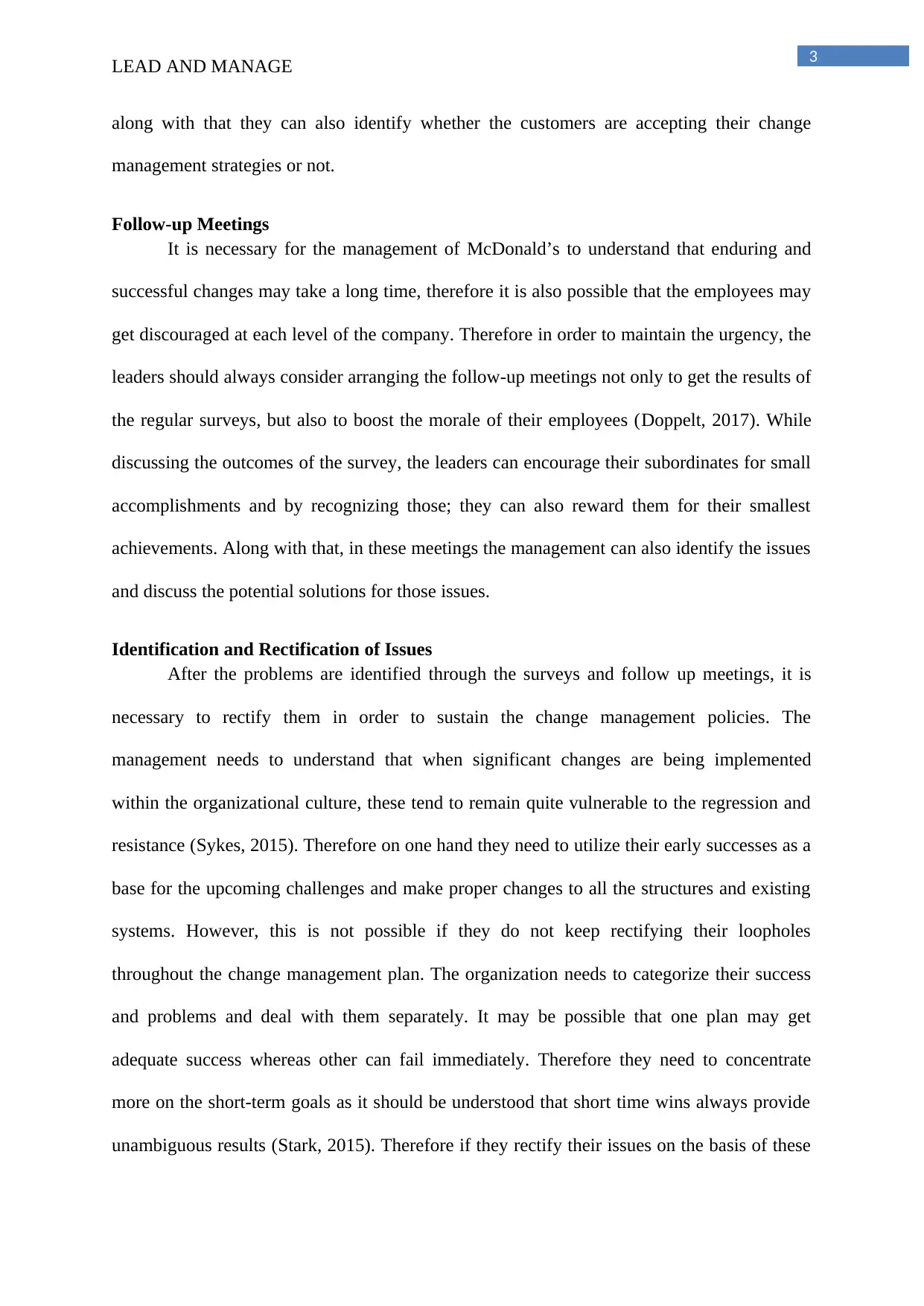
3
LEAD AND MANAGE
along with that they can also identify whether the customers are accepting their change
management strategies or not.
Follow-up Meetings
It is necessary for the management of McDonald’s to understand that enduring and
successful changes may take a long time, therefore it is also possible that the employees may
get discouraged at each level of the company. Therefore in order to maintain the urgency, the
leaders should always consider arranging the follow-up meetings not only to get the results of
the regular surveys, but also to boost the morale of their employees (Doppelt, 2017). While
discussing the outcomes of the survey, the leaders can encourage their subordinates for small
accomplishments and by recognizing those; they can also reward them for their smallest
achievements. Along with that, in these meetings the management can also identify the issues
and discuss the potential solutions for those issues.
Identification and Rectification of Issues
After the problems are identified through the surveys and follow up meetings, it is
necessary to rectify them in order to sustain the change management policies. The
management needs to understand that when significant changes are being implemented
within the organizational culture, these tend to remain quite vulnerable to the regression and
resistance (Sykes, 2015). Therefore on one hand they need to utilize their early successes as a
base for the upcoming challenges and make proper changes to all the structures and existing
systems. However, this is not possible if they do not keep rectifying their loopholes
throughout the change management plan. The organization needs to categorize their success
and problems and deal with them separately. It may be possible that one plan may get
adequate success whereas other can fail immediately. Therefore they need to concentrate
more on the short-term goals as it should be understood that short time wins always provide
unambiguous results (Stark, 2015). Therefore if they rectify their issues on the basis of these
LEAD AND MANAGE
along with that they can also identify whether the customers are accepting their change
management strategies or not.
Follow-up Meetings
It is necessary for the management of McDonald’s to understand that enduring and
successful changes may take a long time, therefore it is also possible that the employees may
get discouraged at each level of the company. Therefore in order to maintain the urgency, the
leaders should always consider arranging the follow-up meetings not only to get the results of
the regular surveys, but also to boost the morale of their employees (Doppelt, 2017). While
discussing the outcomes of the survey, the leaders can encourage their subordinates for small
accomplishments and by recognizing those; they can also reward them for their smallest
achievements. Along with that, in these meetings the management can also identify the issues
and discuss the potential solutions for those issues.
Identification and Rectification of Issues
After the problems are identified through the surveys and follow up meetings, it is
necessary to rectify them in order to sustain the change management policies. The
management needs to understand that when significant changes are being implemented
within the organizational culture, these tend to remain quite vulnerable to the regression and
resistance (Sykes, 2015). Therefore on one hand they need to utilize their early successes as a
base for the upcoming challenges and make proper changes to all the structures and existing
systems. However, this is not possible if they do not keep rectifying their loopholes
throughout the change management plan. The organization needs to categorize their success
and problems and deal with them separately. It may be possible that one plan may get
adequate success whereas other can fail immediately. Therefore they need to concentrate
more on the short-term goals as it should be understood that short time wins always provide
unambiguous results (Stark, 2015). Therefore if they rectify their issues on the basis of these
Paraphrase This Document
Need a fresh take? Get an instant paraphrase of this document with our AI Paraphraser
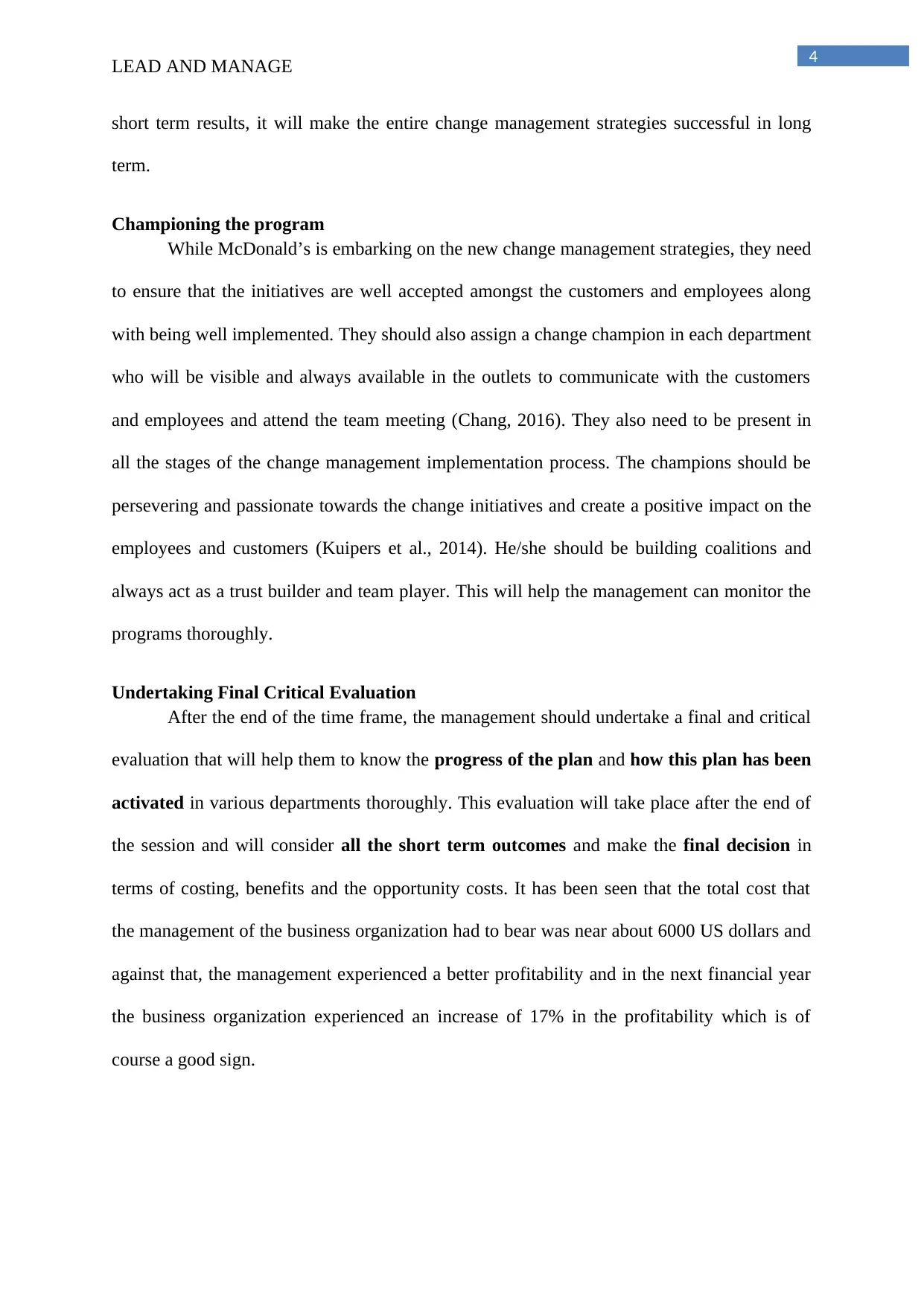
4
LEAD AND MANAGE
short term results, it will make the entire change management strategies successful in long
term.
Championing the program
While McDonald’s is embarking on the new change management strategies, they need
to ensure that the initiatives are well accepted amongst the customers and employees along
with being well implemented. They should also assign a change champion in each department
who will be visible and always available in the outlets to communicate with the customers
and employees and attend the team meeting (Chang, 2016). They also need to be present in
all the stages of the change management implementation process. The champions should be
persevering and passionate towards the change initiatives and create a positive impact on the
employees and customers (Kuipers et al., 2014). He/she should be building coalitions and
always act as a trust builder and team player. This will help the management can monitor the
programs thoroughly.
Undertaking Final Critical Evaluation
After the end of the time frame, the management should undertake a final and critical
evaluation that will help them to know the progress of the plan and how this plan has been
activated in various departments thoroughly. This evaluation will take place after the end of
the session and will consider all the short term outcomes and make the final decision in
terms of costing, benefits and the opportunity costs. It has been seen that the total cost that
the management of the business organization had to bear was near about 6000 US dollars and
against that, the management experienced a better profitability and in the next financial year
the business organization experienced an increase of 17% in the profitability which is of
course a good sign.
LEAD AND MANAGE
short term results, it will make the entire change management strategies successful in long
term.
Championing the program
While McDonald’s is embarking on the new change management strategies, they need
to ensure that the initiatives are well accepted amongst the customers and employees along
with being well implemented. They should also assign a change champion in each department
who will be visible and always available in the outlets to communicate with the customers
and employees and attend the team meeting (Chang, 2016). They also need to be present in
all the stages of the change management implementation process. The champions should be
persevering and passionate towards the change initiatives and create a positive impact on the
employees and customers (Kuipers et al., 2014). He/she should be building coalitions and
always act as a trust builder and team player. This will help the management can monitor the
programs thoroughly.
Undertaking Final Critical Evaluation
After the end of the time frame, the management should undertake a final and critical
evaluation that will help them to know the progress of the plan and how this plan has been
activated in various departments thoroughly. This evaluation will take place after the end of
the session and will consider all the short term outcomes and make the final decision in
terms of costing, benefits and the opportunity costs. It has been seen that the total cost that
the management of the business organization had to bear was near about 6000 US dollars and
against that, the management experienced a better profitability and in the next financial year
the business organization experienced an increase of 17% in the profitability which is of
course a good sign.
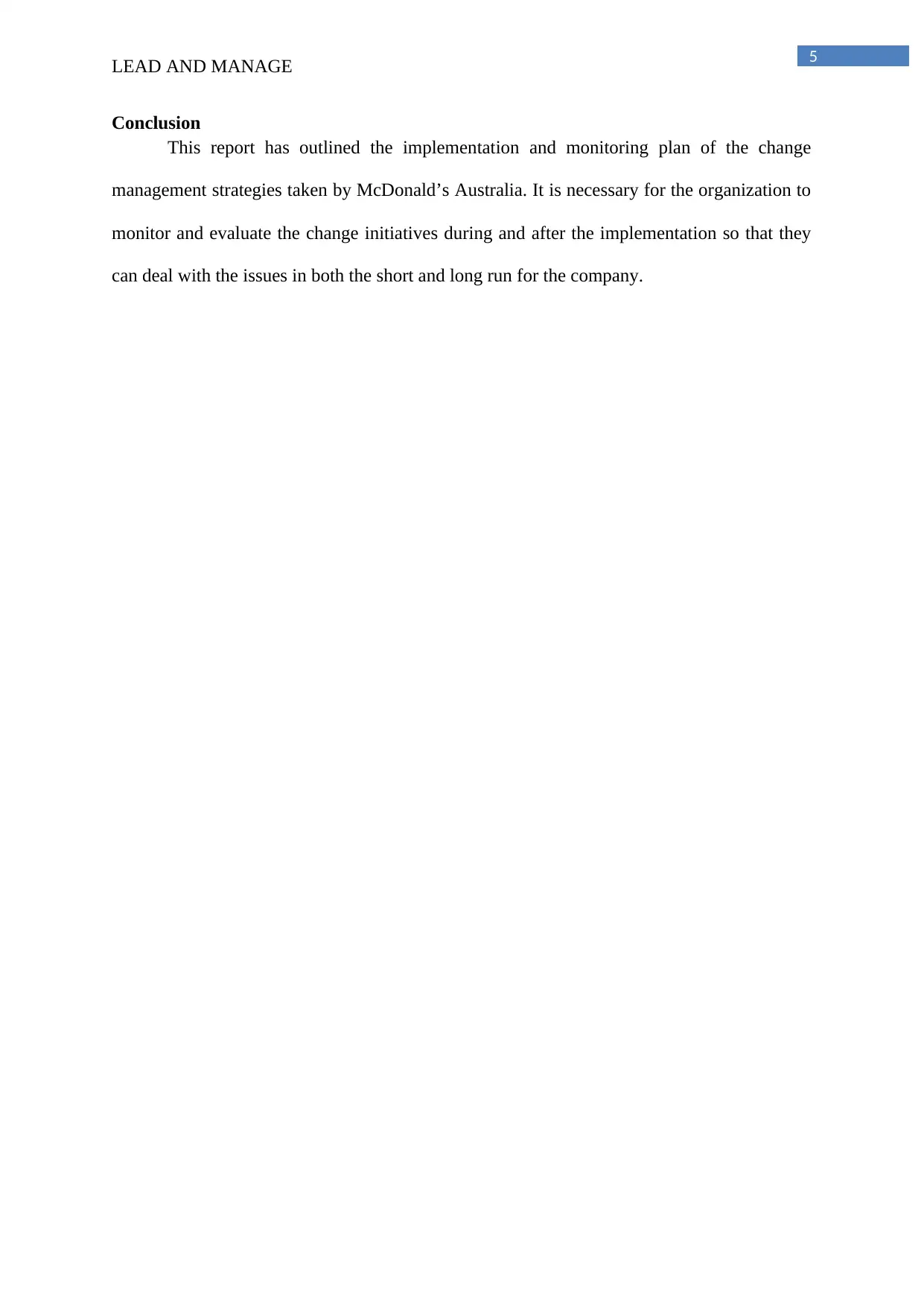
5
LEAD AND MANAGE
Conclusion
This report has outlined the implementation and monitoring plan of the change
management strategies taken by McDonald’s Australia. It is necessary for the organization to
monitor and evaluate the change initiatives during and after the implementation so that they
can deal with the issues in both the short and long run for the company.
LEAD AND MANAGE
Conclusion
This report has outlined the implementation and monitoring plan of the change
management strategies taken by McDonald’s Australia. It is necessary for the organization to
monitor and evaluate the change initiatives during and after the implementation so that they
can deal with the issues in both the short and long run for the company.
⊘ This is a preview!⊘
Do you want full access?
Subscribe today to unlock all pages.

Trusted by 1+ million students worldwide
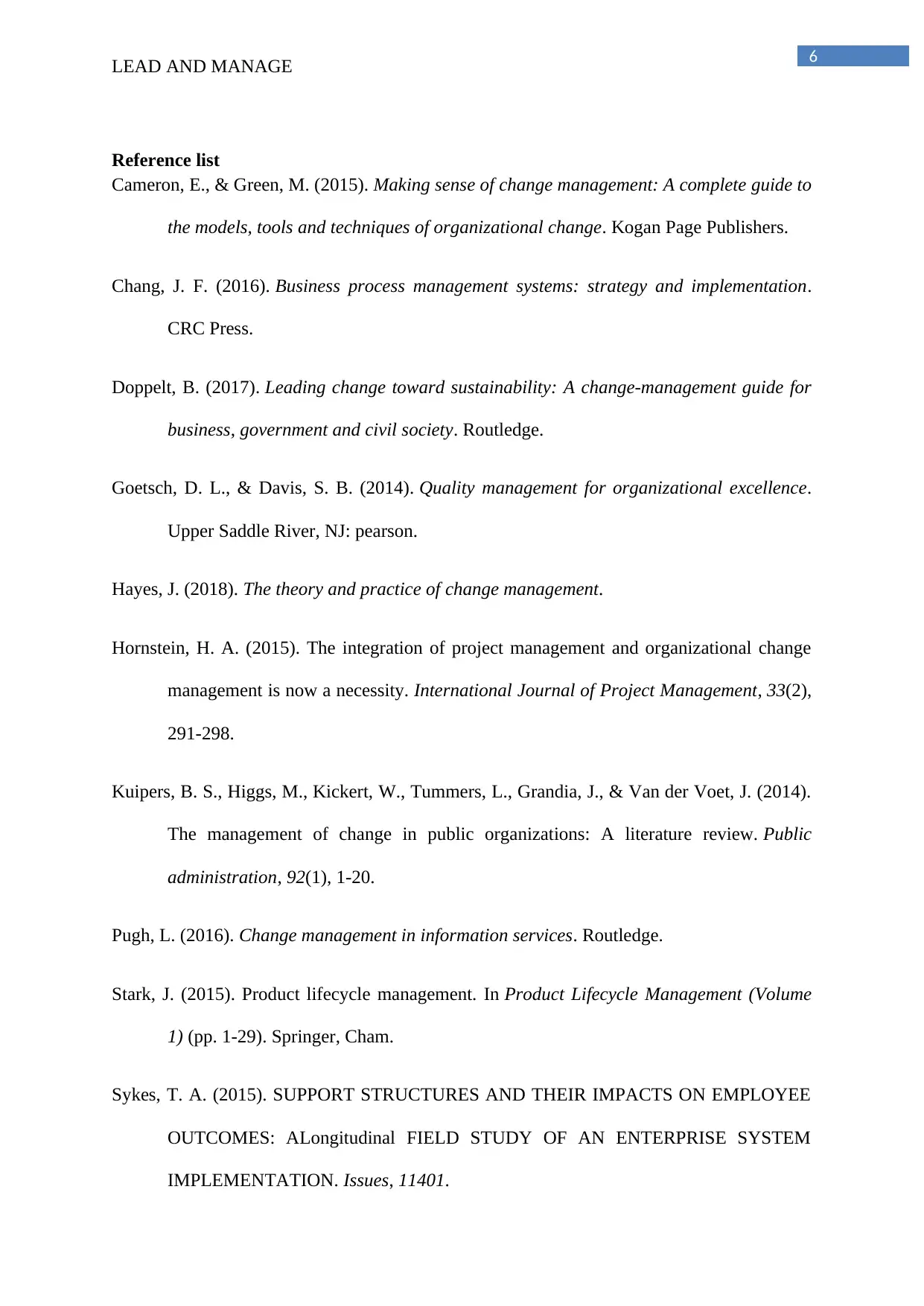
6
LEAD AND MANAGE
Reference list
Cameron, E., & Green, M. (2015). Making sense of change management: A complete guide to
the models, tools and techniques of organizational change. Kogan Page Publishers.
Chang, J. F. (2016). Business process management systems: strategy and implementation.
CRC Press.
Doppelt, B. (2017). Leading change toward sustainability: A change-management guide for
business, government and civil society. Routledge.
Goetsch, D. L., & Davis, S. B. (2014). Quality management for organizational excellence.
Upper Saddle River, NJ: pearson.
Hayes, J. (2018). The theory and practice of change management.
Hornstein, H. A. (2015). The integration of project management and organizational change
management is now a necessity. International Journal of Project Management, 33(2),
291-298.
Kuipers, B. S., Higgs, M., Kickert, W., Tummers, L., Grandia, J., & Van der Voet, J. (2014).
The management of change in public organizations: A literature review. Public
administration, 92(1), 1-20.
Pugh, L. (2016). Change management in information services. Routledge.
Stark, J. (2015). Product lifecycle management. In Product Lifecycle Management (Volume
1) (pp. 1-29). Springer, Cham.
Sykes, T. A. (2015). SUPPORT STRUCTURES AND THEIR IMPACTS ON EMPLOYEE
OUTCOMES: ALongitudinal FIELD STUDY OF AN ENTERPRISE SYSTEM
IMPLEMENTATION. Issues, 11401.
LEAD AND MANAGE
Reference list
Cameron, E., & Green, M. (2015). Making sense of change management: A complete guide to
the models, tools and techniques of organizational change. Kogan Page Publishers.
Chang, J. F. (2016). Business process management systems: strategy and implementation.
CRC Press.
Doppelt, B. (2017). Leading change toward sustainability: A change-management guide for
business, government and civil society. Routledge.
Goetsch, D. L., & Davis, S. B. (2014). Quality management for organizational excellence.
Upper Saddle River, NJ: pearson.
Hayes, J. (2018). The theory and practice of change management.
Hornstein, H. A. (2015). The integration of project management and organizational change
management is now a necessity. International Journal of Project Management, 33(2),
291-298.
Kuipers, B. S., Higgs, M., Kickert, W., Tummers, L., Grandia, J., & Van der Voet, J. (2014).
The management of change in public organizations: A literature review. Public
administration, 92(1), 1-20.
Pugh, L. (2016). Change management in information services. Routledge.
Stark, J. (2015). Product lifecycle management. In Product Lifecycle Management (Volume
1) (pp. 1-29). Springer, Cham.
Sykes, T. A. (2015). SUPPORT STRUCTURES AND THEIR IMPACTS ON EMPLOYEE
OUTCOMES: ALongitudinal FIELD STUDY OF AN ENTERPRISE SYSTEM
IMPLEMENTATION. Issues, 11401.
1 out of 7
Related Documents
Your All-in-One AI-Powered Toolkit for Academic Success.
+13062052269
info@desklib.com
Available 24*7 on WhatsApp / Email
![[object Object]](/_next/static/media/star-bottom.7253800d.svg)
Unlock your academic potential
Copyright © 2020–2025 A2Z Services. All Rights Reserved. Developed and managed by ZUCOL.




